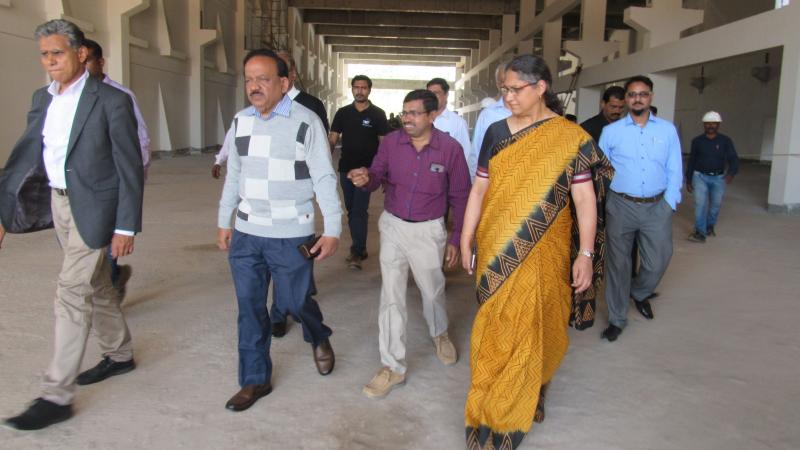
Dr. Harsh Vardhan, Hon’ble Union Minister for Science and Technology, Environment, Forest and Climate Change and Earth Sciences, Govt. of India visited the Centre for Research and Education in Science and Technology (CREST), Indian Institute of Astrophysics (IIA) at Hosakote. He was welcomed by Prof. P Sreekumar, Director of IIA and Prof. G C Anupama, Dean and Professor-in-charge of CREST and others at CREST.
CREST is a 40 acre sprawling campus with various facilities for space research. The campus houses the control room for remote operations of the two meter Himalayan Chandra Telescope (HCT), a part of the Indian Astronomical Observatory (IAO) located at Hanle, Ladakh. It also houses the upcoming Thirty Meter Telescope optics fabrication facility, where mirrors for the 30 meter telescope will be fabricated.
“The HCT is used to detect transient sources, like supernovae, which lasts only for a short time. It can be moved quickly to observe such fast phenomenon. It has also been used to explore exoplanets—a planet that lies outside our solar system” explains Prof. G C Anupama, Dean and Professor in-charge of IAO and CREST.
After an introduction to the remote operating capability at CREST, Dr. Harsh Vardhan interacted with engineers and scientist at IAO, Hanle via a video conference. The engineers explained the various parts and functionalities of the HCT, while the scientists explained the various observations it could be used for.
Following this, Dr. Harsh Vardhan also interacted with a few students who were working on the upcoming Thirty Meter Telescope (TMT).
“Indian science is already comparable and, in some cases, exceeds that of anywhere else in the world. The Thirty Meter Telescope is a testament to this” remarked Dr. Harsh Vardhan during the visit. After the interaction, Dr. Harsh Vardhan visited the India TMT optics fabrication facility (ITOFF) at CREST and planted a sapling. Once operational, ITOFF will be the only facility in India for polishing thin, aspherical mirror segments. India’s share of 86 mirror segments of the TMT will be fabricated at this facility.
The TMT project is an international partnership between California Institute of Technology (CALTECH) and Universities in California, Canada, Japan, China and India. The telescope which was originally planned to come up near Mauna Kea in Hawaii, USA, is now expected to be built in Mauna kea, Hawaii or La Palma, in Canary Islands of Spain. Once built, it will be one of the largest land based telescopes, with nine times the light-gathering power of today’s best telescopes. Its massive 30 meter mirror will be comprised of segments made of 492 smaller individual mirrors. After it is operational, TMT will be a general purpose telescope, exploring great mysteries like the black holes at the center of galaxies, birth and evolution of galaxies, birth, evolution and death of stars and many more.

Editor’s note: There was an error in the mention of the place where the TMT would come up and it has a 30 metre mirror and not 30 foot mirror as stated earlier. The errors are regretted.






